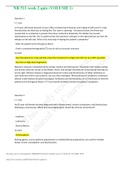College aantekeningen
College notes GEO1-2203 Science of Energy Technologies (GEO1-2203)
The notes include lecture 1-7 and 9-14. The 8th and 15th lecture would not be included in the exam. Next to notes of the lectures and handwritten notes on information on the book (including many equations), tutorials 1-65and 9-13 are also added. The tutorials include all questions and answers.
[Meer zien]













